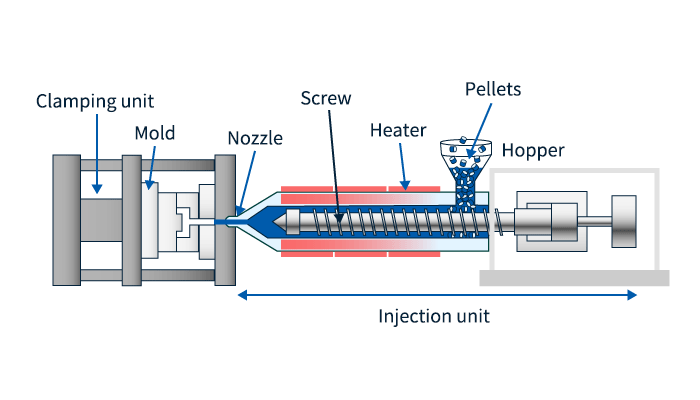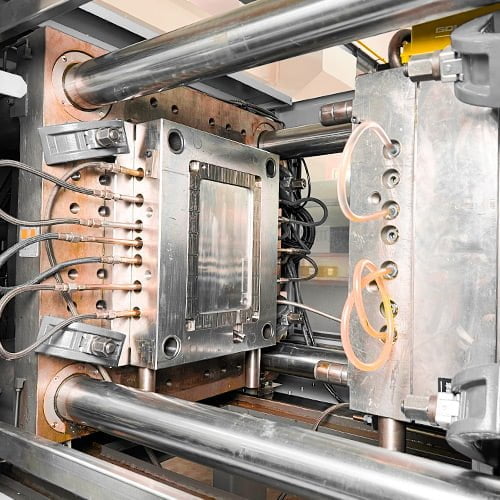Comprehending the Essentials of Plastic Injection Molding Processes
Plastic shot molding works as a cornerstone of contemporary production, giving a methodical method to generating intricate components with precision. This process not just encompasses the essential actions of melting and infusing products right into mold and mildews yet also involves a nuanced understanding of various affecting variables, such as temperature and pressure. As sectors significantly require performance and top quality, the complexities of this approach end up being a lot more essential. Exploring these important aspects might reveal how even minor adjustments can lead to significant improvements in manufacturing end results, elevating inquiries concerning the possibility for technology in this well-known process.
What Is Plastic Injection Molding?
Plastic shot molding is a widely used production process that changes thermosetting and polycarbonate materials right into precise and intricate forms. This method is favored for its capacity to produce high quantities of identical get rid of remarkable precision, making it an essential approach in various markets, consisting of automotive, durable goods, and clinical devices.
The process includes thawing the picked plastic material and injecting it right into a mold and mildew under high pressure. The mold, created to the requirements of the desired part, enables the liquified plastic to form as it solidifies and cools. When the product has actually hardened, the mold is opened, and the completed part is expelled.
Plastic shot molding supplies several advantages, including decreased waste, uniformity in manufacturing, and the ability to include detailed layouts that may be challenging with other producing techniques. In addition, it sustains a wide series of products, each giving unique residential properties that can be customized for details applications. As sectors remain to introduce, plastic shot molding stays at the leading edge, allowing the development of advanced items that fulfill developing consumer demands.
The Injection Molding Refine
The shot molding process is a sophisticated technique that entails several crucial phases to create premium plastic elements. Plastic pellets are fed into a heated barrel where they are thawed into a viscous fluid. This molten plastic is then injected under high stress into a precision-engineered mold, which forms the material right into the preferred type.
Once the mold and mildew is filled up, the plastic is allowed to strengthen and cool, taking the shape of the mold tooth cavity. Air conditioning time is vital, as it impacts the cycle time and the final residential or commercial properties of the shaped part. After enough air conditioning, the mold opens up, and the finished part is ejected making use of ejector pins.
Products Utilized in Injection Molding
Different materials can be utilized in the injection molding process, each offering special properties that cater to particular applications. The most typically utilized materials include thermoplastics, thermosetting plastics, and elastomers.

Thermosetting plastics, like epoxy and phenolic resins, go through a chemical adjustment during the treating procedure, resulting in a stiff, stringent structure. These materials are excellent for applications requiring this link high heat resistance and structural stability, usually used in electric insulators and auto parts.
Elastomers, consisting of silicone and rubber-based products, provide versatility and durability. Their special homes make them suitable for applications that demand elasticity, such as seals and gaskets.
Furthermore, specialized products like bio-based plastics and compounds are gaining traction for their environmental benefits and improved performance attributes, widening the range of shot molding applications in different sectors. Comprehending the residential properties of these materials is important for picking the ideal type for particular jobs.
Advantages of Injection Molding
Injection molding stands apart as a highly efficient manufacturing process that offers numerous benefits for generating complicated get rid of precision. One of the most substantial advantages is the capability to produce elaborate designs that would certainly be impossible or challenging to achieve with various other techniques (Plastic Injection Molding). The procedure permits limited resistances and comprehensive features, ensuring high-quality parts
Furthermore, injection molding is recognized for its fast production capacities, making it a suitable option for high-volume click over here now manufacturing. As soon as the mold is developed, parts can be produced swiftly, decreasing preparations and boosting overall performance. This effectiveness not just reduces manufacturing expenses but additionally provides an one-upmanship in the marketplace.
The flexibility of products utilized in injection molding even more boosts its appeal. A vast array of thermoplastics and thermosetting polymers can be employed, allowing manufacturers to choose products that ideal meet their certain needs, consisting of warm, stamina, and flexibility resistance.
Furthermore, the process reduces waste, as excess material can typically be recycled and reused. This sustainability element adds to a lowered environmental effect, making injection molding a responsible manufacturing option. Overall, the benefits of injection molding make it why not find out more a favored method for many sectors.
Elements Influencing Product Quality
While many variables can influence product high quality in shot molding, understanding these components is important for achieving optimum outcomes. Trick elements include product option, processing criteria, and mold and mildew style.
Material option plays an essential duty, as different polymers display one-of-a-kind buildings that impact flowability, strength, and thermal stability. Inadequate product selection can lead to problems such as warping or insufficient filling.
Handling parameters, including cycle, temperature level, and stress time, should be carefully regulated. Variants in these settings can lead to disparities in component measurements and surface finish. Excessively high temperatures may create destruction of the polymer, while inadequate stress can result in short shots.
Mold and mildew design is similarly crucial, as it determines the circulation of the molten plastic and the cooling procedure. Improperly developed molds may bring about uneven cooling rates, resulting in dimensional inaccuracies and residual stresses.

Final Thought
Finally, plastic injection molding acts as a critical production procedure that makes it possible for the effective production of premium elements. Mastery of the injection molding procedure, including the understanding of materials and the impact of different factors on item high quality, is essential for achieving optimum outcomes. The benefits of this method, such as cost-effectiveness and style adaptability, more underscore its significance throughout multiple industries, strengthening its standing as a favored selection for high-volume manufacturing.
Plastic injection molding offers as a foundation of contemporary manufacturing, providing a systematic method to creating complicated parts with precision.Plastic injection molding supplies a number of benefits, including lowered waste, consistency in production, and the capability to incorporate elaborate designs that might be challenging with various other making methods (Plastic Injection Molding). As markets continue to introduce, plastic injection molding continues to be at the center, making it possible for the growth of advanced products that satisfy evolving customer needs
The injection molding process is a sophisticated strategy that includes numerous essential phases to generate top notch plastic components.In verdict, plastic shot molding serves as a crucial manufacturing procedure that enables the reliable production of premium parts.